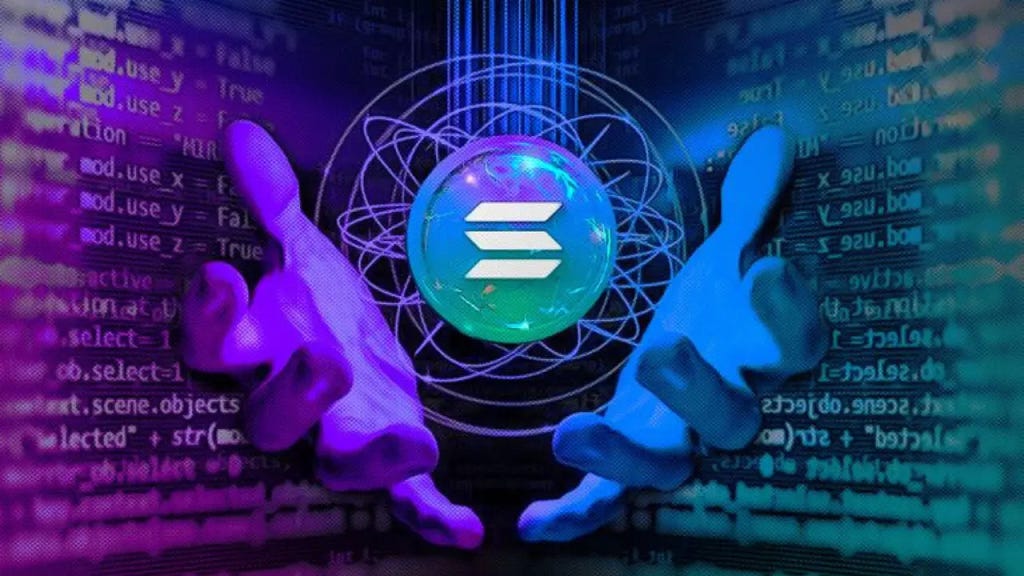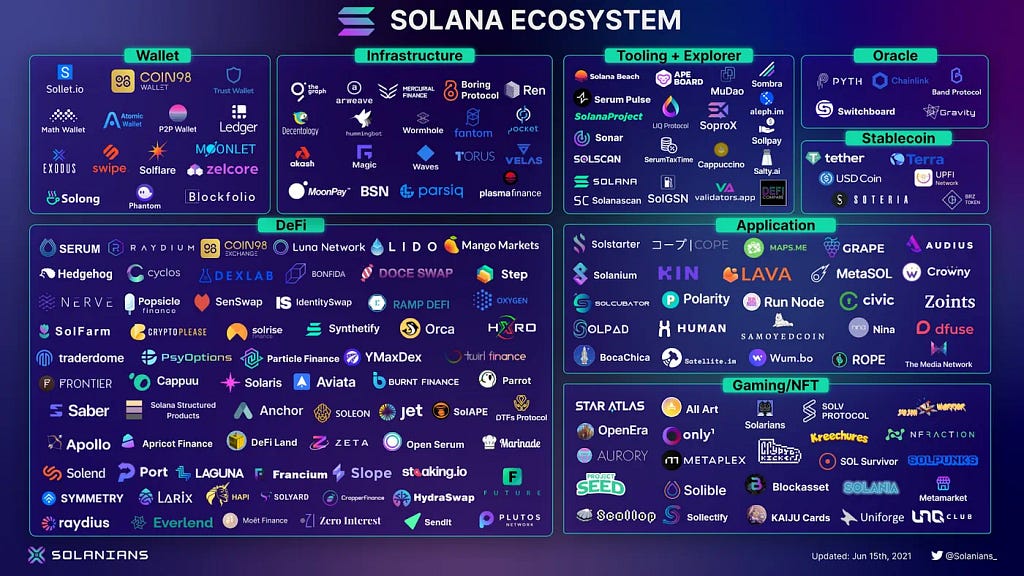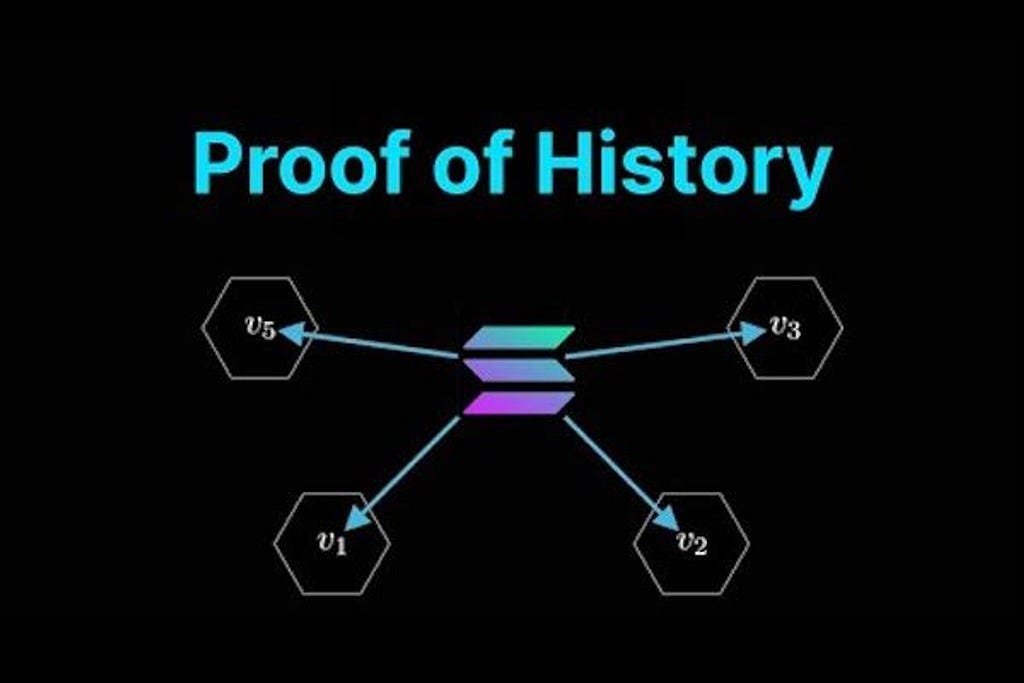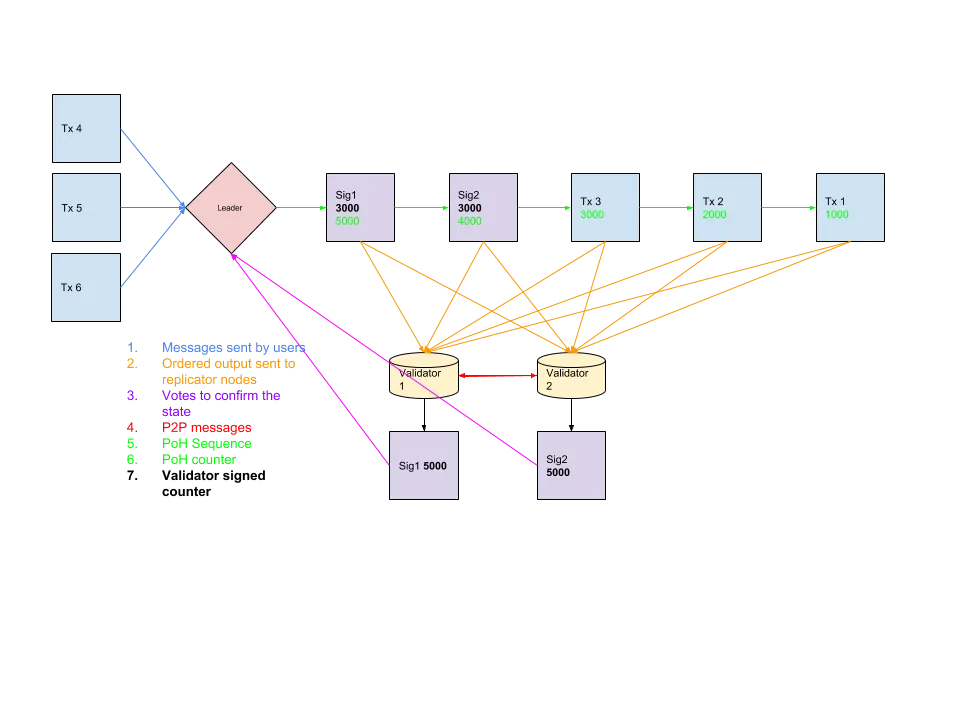THE ESSENTIAL HANDBOOK ON ARTIFICIAL INTELLIGENCE IN ACCOUNTING

In the ever-evolving landscape of blockchain technology, the Solana ecosystem emerges as a beacon of innovation, speed, and efficiency. With its groundbreaking approach to scalability and performance, Solana has captivated the attention of developers, investors, and enthusiasts alike. This introduction aims to unravel the complexities of Solana’s system architecture, offering insights into its unique components and operational dynamics.
At the heart of Solana’s prowess lies its distinctive system architecture, meticulously designed to harness the full potential of blockchain technology. Through its innovative components, such as the Leader, Verifiers, and Validators, Solana orchestrates a symphony of transactions with unparalleled precision and speed. The ecosystem’s backbone, the Proof of History mechanism, ensures a seamless and chronological sequence of events, setting a new standard for trust and reliability in the digital realm.
Understanding the intricacies of Solana’s network limits and computational capabilities further illuminates its technological superiority. The ecosystem is adept at handling a staggering number of transactions, underpinned by a robust computational infrastructure that leverages GPU-based verification and sophisticated memory management. This enables Solana to achieve remarkable throughput, making it a formidable player in the competitive blockchain space.
The introduction of high-performance smart contracts in Solana’s framework marks a significant leap forward. These contracts, powered by advanced programming languages and efficient execution models, are the linchpin of Solana’s adaptability and functionality. They facilitate a myriad of applications, from decentralized finance (DeFi) platforms to complex decentralized applications (dApps), showcasing the ecosystem’s versatility and potential for innovation.
As we delve deeper into the nuances of Solana’s system architecture, it becomes evident that this blockchain is not just a technological marvel but a vision of the future. A future where scalability, speed, and security coalesce to create a seamless, decentralized digital world. Join us on this exploratory journey as we dissect the components, operations, and limitless possibilities of the Solana ecosystem. Whether you’re a seasoned blockchain aficionado or a curious newcomer, the insights provided herein will equip you with a comprehensive understanding of what makes Solana a groundbreaking force in the realm of blockchain technology.
Demystifying Solana: A Revolutionary Blockchain Explained
Introduction to Solana’s Innovative Approach
Blockchain technology, at its core, is like a digital ledger that is exceptionally resistant to tampering, mimicking a highly reliable record-keeping system. Traditional blockchains, however, face a significant challenge: they do not effectively utilize time. Most blockchain networks operate with each node (or participant) relying on its own clock, unaware of the time kept by others. This disconnection can lead to discrepancies when nodes make decisions based on timestamps, potentially compromising the network’s reliability. Solana introduces a groundbreaking solution called Proof of History (PoH), fundamentally changing how time is recorded on the blockchain. PoH allows for a verifiable timeline of events, ensuring all network participants can trust the sequence and timing of transactions without needing to trust each other.
Navigating the Solana Ecosystem

Our exploration of Solana is structured into several focused discussions:
1. System Design Overview: We’ll begin with a bird’s-eye view of Solana’s unique architecture, setting the stage for a deeper dive into its components.
2. Deep Dive into Proof of History: Unpacking the mechanics of PoH, we’ll see how Solana timestamps transactions in a revolutionary way.
3. Exploring Proof of Stake: Next, we delve into Solana’s consensus mechanism, highlighting its efficiency and security advantages.
4. Understanding Fast Proof of Replication: This part covers how Solana ensures data is accurately and swiftly replicated across the network.
5. Architectural Insights and Performance Limits: We’ll examine the structural underpinnings of Solana’s network and its scalability potentials.
6. GPU-Friendly Smart Contracts: Finally, we’ll touch upon how Solana optimizes smart contracts for high performance using GPU technology.
Network Design: The Heart of Solana’s Efficiency
At any moment within Solana’s network, a specific node takes the lead, acting as the “Leader.” This Leader is responsible for generating a Proof of History sequence, essentially creating a reliable timeline that ensures consistency across the network. It organizes and processes user transactions in an order that allows for optimal efficiency, storing the current state in RAM. After executing these transactions, the Leader then broadcasts the results along with a final state signature to nodes known as “Verifiers.”
These Verifiers replicate the Leader’s actions on their copies of the state, producing signatures to confirm the transactions’ validity. These confirmations act as votes within Solana’s consensus mechanism, ensuring network agreement and security.
Ensuring Fair Leadership and Network Recovery
Solana’s network operates under a democratic principle where any Verifier has the potential to become a Leader, thanks to elections based on the Proof of Stake (PoS) model. This approach not only enhances security but also ensures a fair and decentralized system of governance.
In the event of network disruptions, Solana proposes innovative recovery mechanisms to regain control, regardless of the disruption’s scale. This resilience underscores Solana’s commitment to maintaining a consistent and available network, prioritizing consistency in line with the CAP theorem, even in the face of partitions or splits within the network.
By addressing the fundamental challenges of time and trust in blockchain, Solana’s innovative design and mechanisms pave the way for a more scalable, efficient, and democratic digital ledger system. Through its architectural innovations, Solana promises to significantly enhance the performance and reliability of blockchain technology, making it a fascinating subject for both enthusiasts and professionals in the field.
Demystifying Solana’s Proof of History
Unlocking the Secrets of Time on the Blockchain
In the complex world of blockchain technology, Solana introduces a revolutionary concept called Proof of History (PoH). But what exactly is PoH, and how does it work? Let’s delve into the intricacies of this fascinating concept.
What is Proof of History?
Proof of History acts as a digital clock, allowing us to verify the passage of time between events on the blockchain. It employs a sophisticated cryptographic function that ensures the output cannot be predicted, offering a secure and reliable way to organize events.
How Does it Work?
Imagine a sequence of steps, like pieces of a puzzle, where each step builds upon the previous one. Solana’s PoH operates similarly, running a cryptographic function in a sequence on a single core. This function takes the previous output as its current input and records the output at each step. The result is a chronological sequence of outputs, each dependent on the one before it.
Timestamping Events
One of the remarkable features of PoH is its ability to timestamp events. By appending data into the sequence, such as a photograph or any digital information, we can mark the exact moment it occurred. This timestamping ensures the integrity and chronological order of events on the blockchain.
Ensuring Security and Scalability
PoH not only guarantees the passage of time but also supports horizontal scaling. Multiple PoH generators can synchronize with each other, expanding the capacity of the system without compromising security. This synchronization allows for a seamless flow of events across the network.
Verifying the Sequence
Verifying the correctness of the sequence is remarkably efficient. By using multicore computers, we can verify the sequence in significantly less time than it took to generate it. This ensures that the recorded events are accurate and tamper-proof.
Defending Against Attacks
Despite its robustness, PoH is not immune to attacks. However, Solana has implemented measures to safeguard against various threats, including reversal attacks and long-range attacks. By combining PoH with other protocols like Proof of Replication (PoRep), the network enhances its defenses against forged ledgers.
Proof of History is a groundbreaking concept that brings unprecedented levels of security and scalability to the blockchain. By providing a verifiable timeline of events, Solana’s PoH ensures the integrity and reliability of transactions in the digital world. As blockchain technology continues to evolve, PoH stands as a testament to innovation and progress.
Simplifying Solana’s Proof of Stake Consensus
Understanding Proof of Stake in Solana
Solana takes a unique approach to blockchain consensus through Proof of Stake (PoS), designed for speedy transaction validation, selection of sequence generators, and penalizing any misbehaving participants. This system relies on the assumption that messages reach all nodes within a specific timeframe.
Key Concepts Explained
- Bonds: Think of bonds as the blockchain equivalent of an investment in mining equipment in Proof of Work systems. Validators, or those who confirm transactions, lock up a certain amount of Solana coins as collateral.
- Slashing: A measure to ensure validators don’t approve conflicting transactions. If a validator is caught doing so, their bonded coins can be destroyed, serving as a deterrent.
- Super Majority: This term refers to having more than two-thirds of validators in agreement, which signifies a consensus. For a false branch to be validated, over one-third of the network would need to act maliciously, making deceit expensive.
How It Works: From Bonding to Elections
1. Bonding: Validators lock up coins in a bond to participate. These coins are untouchable until certain conditions are met, ensuring validators have skin in the game.
2. Voting: Validators confirm the sequence of transactions generated by the Proof of History (PoH) system by publishing their acknowledgment. A super majority’s approval solidifies the sequence’s legitimacy.
3. Unbonding: If a validator fails to vote enough times, their coins become stale and can be withdrawn, preventing them from participating further.
4. Elections for New Generators: Should the current PoH generator fail, a new one is elected based on voting power, ensuring the blockchain’s continuous operation.
5. Dealing with Forks and Failures: Solana anticipates issues like forks, runtime exceptions, or network timeouts, with mechanisms to initiate new elections or fallbacks to secondary generators.
Ensuring Network Availability and Recovery
Solana prioritizes availability but balances it with consistency, using the objective measure of time provided by PoH. It dynamically adjusts to network conditions, ensuring that validators who are offline for too long can be phased out, allowing the network to recover and continue validating transactions.
Protection Against Attacks
Solana is designed to resist various attacks, including:
- Tragedy of Commons: Validators are incentivized to perform their duties honestly, with random checks in place.
- Collusion: Measures are in place to prevent unfair advantages when validators might collude with the PoH generator.
- Censorship and Long-Range Attacks: The system dynamically adjusts to prevent a minority from overtaking the network and ensures that recovering the ledger to initiate an attack is impractical.
Solana’s Proof of Stake consensus is a complex but well-thought-out system designed to ensure speed, security, and fairness in the blockchain. Through a combination of economic incentives, penalties, and dynamic adjustments, it aims to maintain a robust and efficient network.
Simplifying Solana’s Streaming Proof of Replication
Introduction to Streaming Proof of Replication
Imagine you’re sending a valuable package through the mail. You’d want a way to ensure that the package not only arrives but also that it hasn’t been tampered with along the way. In the digital world, especially in blockchain technologies like Solana, a similar challenge exists for data storage. Solana offers a solution known as Streaming Proof of Replication. This technology ensures that data (or in our analogy, the package) is safely stored and remains unchanged.
How It Works: A Simple Breakdown
The Goal: To quickly and efficiently check that data stored across different computers in the blockchain network remains unchanged and accessible.
The Process:
1. Encryption Magic: Data blocks are encrypted in a chain, where each piece is mixed with the previous one using a method known as CBC encryption. This creates a secure and interconnected data sequence.
2. Unique Keys: Every participant or “replicator” in the network creates a unique key by signing off on a specific data sequence. This binds their identity to the data they’re responsible for.
3. Choosing the Data: A special method is used to pick random bits of data from each block. Think of it like randomly checking pages in a sealed book to ensure they’re correct without having to read every single page.
4. Verifying the Data: A complex tree of data, known as a merkle hash, is created from these random bits. The top of this tree (the root) is then shared, proving that the replicator has the correct data without revealing all of it.
Ensuring Integrity and Fighting Fraud
To maintain trust and security, the system employs several mechanisms:
- Regular Key Updates: Changing the encryption keys regularly prevents anyone from taking shortcuts in proving they have the correct data.
- Hash Selection: A special kind of digital fingerprint is used for encryption, ensuring everyone uses the same standard for verification.
- Verification Process: Other computers in the network check these proofs without having to verify the entire data set themselves.
Tackling Potential Threats
Solana’s system is designed to be resilient against several types of attacks, such as:
- Spam Attacks: By requiring the sharing of encrypted data and verification trees, it becomes impractical to overwhelm the network with fake data.
- Data Erasure: Random checks and the method of selecting data make it extremely hard for someone to cheat by deleting parts of the data they’re supposed to store.
- Collusion and Sabotage: Even if a bad actor tries to manipulate the system, the unique way in which data is tied to each participant’s identity and the cryptographic safeguards make such attempts futile.
Solana’s Streaming Proof of Replication is like a high-tech, highly secure method of ensuring that data stored across its blockchain remains safe, untampered, and readily accessible. It combines cryptography, random sampling, and community verification in a way that safeguards against data loss or fraud, ensuring the integrity and reliability of the network’s storage capabilities.
Demystifying Solana’s System Architecture
Understanding the Building Blocks of Solana’s Advanced Blockchain Design
In the intricate world of blockchain technology, Solana stands out with its innovative architecture. Let’s dive into the key components that make up Solana’s system and unravel the complexities.
Unveiling the Components
1. Leader, Proof of History Generator: Picture the “Leader” as the conductor of an orchestra, but instead of music, it orchestrates transactions in Solana’s blockchain. It generates a unique sequence of all transactions, ensuring a consistent order. After processing each batch, it signs off with its unique identity.
2. State: Think of the state as a massive digital filing cabinet. It stores all the necessary information about users, transactions, and more. For instance, the “Transaction Table” stores user addresses and transaction details, while the “Proof of Stake Bonds Table” keeps track of validators and their stakes.
3. Verifier, State Replication: Verifiers act as guardians of the blockchain’s state, ensuring it remains accessible and reliable. They replicate the state across multiple nodes, enhancing its availability. Validators, chosen through consensus, select and endorse these verifiers based on predefined criteria.
4. Validators: Validators are like virtual assistants to the verifiers. They assist in maintaining the blockchain’s integrity and can operate on the same machines as verifiers or separately, depending on the network’s configuration.
Setting Boundaries: Network and Computational Limits
- Network Limits: The network must efficiently handle incoming transactions. Solana optimizes this process by organizing packets of transactions into a sequence, minimizing errors, and maximizing efficiency. These packets contain crucial data like transaction details, signatures, and more, ensuring smooth processing.
- Computational Limits: Every transaction requires verification, a process that can be parallelized for efficiency. Solana’s system leverages GPU-based verification servers for lightning-fast operations. Additionally, memory constraints are carefully managed to handle billions of accounts and transactions seamlessly.
Unleashing High-Performance Smart Contracts
Smart contracts are the brains behind Solana’s operations, executing tasks and modifying the state. Leveraging advanced programming languages and optimized bytecode, Solana ensures efficient contract execution. Its unique design allows for zero-cost interactions and seamless integration with high-performance servers, enhancing throughput and scalability.
Solana’s system architecture is a masterpiece of innovation and efficiency. By carefully orchestrating transactions, optimizing network and computational resources, and empowering smart contracts, Solana delivers unmatched performance and reliability in the blockchain space. As we continue to explore the world of decentralized technologies, Solana shines as a beacon of progress and possibility.
Embracing the Future: The Unparalleled Potential of Solana
As we delve into the intricate design and operational mechanics of Solana’s blockchain ecosystem, it becomes evident that Solana is not just another addition to the plethora of blockchain technologies; it is a monumental leap towards realizing the full potential of decentralized applications. Through its innovative system architecture, Solana addresses critical challenges that have long plagued blockchain networks — scalability, speed, and security.
The introduction of concepts such as the Proof of History, along with a robust system of Leaders, Validators, and Verifiers, distinguishes Solana as a pioneer in the blockchain space, poised to redefine the boundaries of transaction speed and network efficiency. Its unique approach to handling transactions and state replication, coupled with the groundbreaking method of leveraging smart contracts, positions Solana as a formidable platform for developers and users alike.
Moreover, Solana’s impressive computational and memory capabilities underscore its readiness to support a future where decentralized applications operate with unprecedented efficiency. The ecosystem’s capacity to facilitate millions of transactions per second, all while maintaining a secure and decentralized network, heralds a new era for blockchain technology.
In conclusion, Solana’s innovative architecture and its commitment to pushing the envelope of what’s possible within the blockchain space illuminate a path towards a more scalable, efficient, and inclusive digital future. As the ecosystem continues to evolve and expand its horizons, the potential applications of Solana’s technology are boundless. We stand on the brink of a transformative period in blockchain’s history, with Solana leading the charge towards a more decentralized, efficient, and accessible world.
LinkedIn: felipe-rainel
Email: [email protected]
Navigating the Solana Ecosystem: A Primer was originally published in Coinmonks on Medium, where people are continuing the conversation by highlighting and responding to this story.
